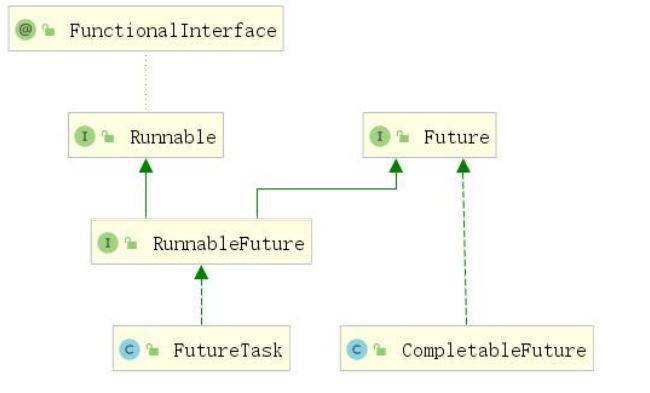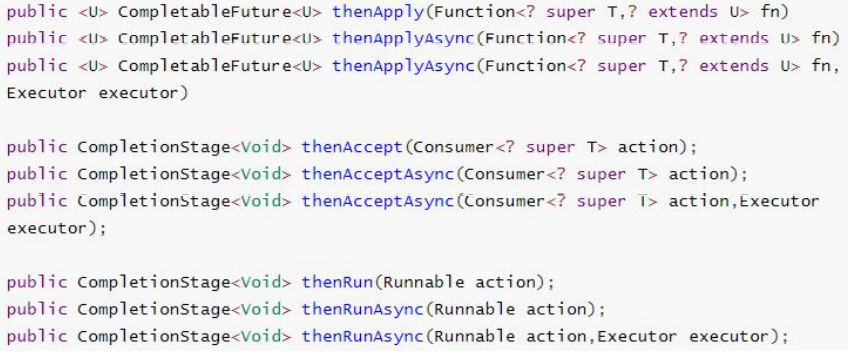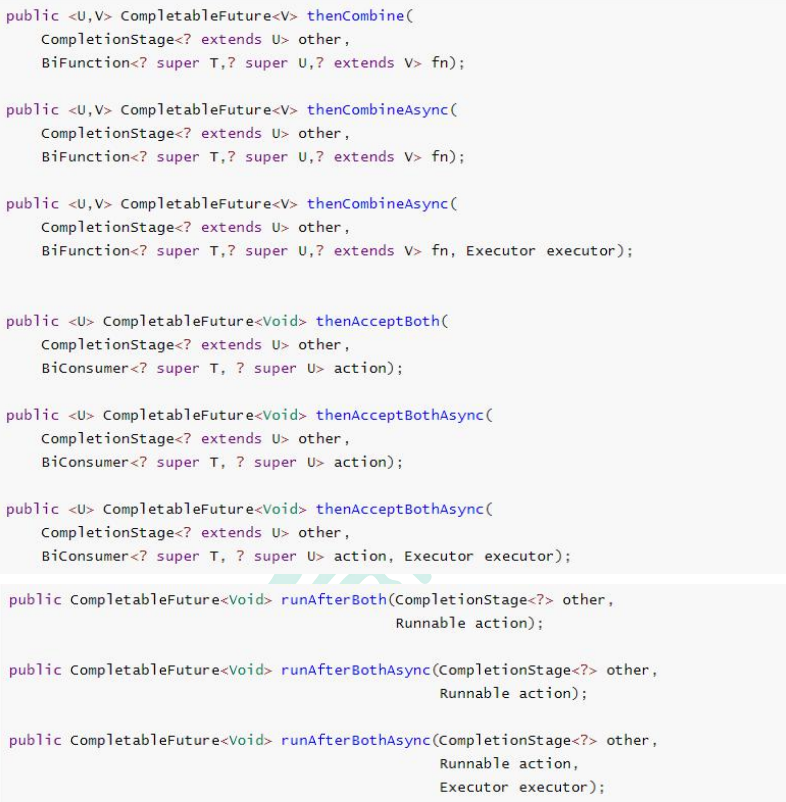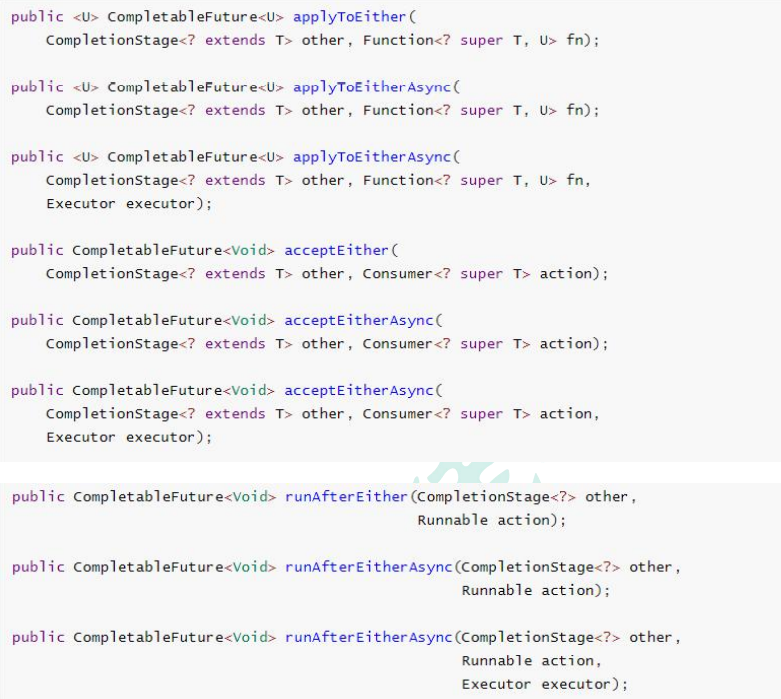Future 是 Java 5 添加的类,用来描述一个异步计算的结果。你可以使用isDone方法检查计算是否完成,或者使用get阻塞住调用线程,直到计算完成返回结果,你也可以使用cancel 方法停止任务的执行。
虽然 Future 以及相关使用方法提供了异步执行任务的能力,但是对于结果的获取却是很不方便,只能通过阻塞或者轮询的方式得到任务的结果。阻塞的方式显然和我们的异步编程的 初衷相违背,轮询的方式又会耗费无谓的 CPU 资源,而且也不能及时地得到计算结果,为什么不能用观察者设计模式当计算结果完成及时通知监听者呢?
很多语言,比如 Node.js,采用回调的方式实现异步编程。Java 的一些框架,比如 Netty,自己扩展了 Java 的 Future 接口,提供了 addListener 等多个扩展方法;Google guava 也提供了通用的扩展 Future;Scala 也提供了简单易用且功能强大的 Future/Promise 异步编程模式。
作为正统的 Java 类库,是不是应该做点什么,加强一下自身库的功能呢?
在 Java 8 中, 新增加了一个包含 50 个方法左右的类: CompletableFuture,提供了非常强大的 Future 的扩展功能,可以帮助我们简化异步编程的复杂性,提供了函数式编程的能力,可以通过回调的方式处理计算结果,并且提供了转换和组合 CompletableFuture 的方法。 CompletableFuture 类实现了 Future 接口,所以你还是可以像以前一样通过get方法阻塞或者轮询的方式获得结果,但是这种方式不推荐使用。
CompletableFuture 和 FutureTask 同属于 Future 接口的实现类,都可以获取线程的执行结果。
1. 异步对象创建 CompletableFuture 提供了如下四个静态方法来创建一个异步操作:
创建示例:
runAsync(Runnable runnable, Executor executor ) 1 2 3 4 5 6 7 8 9 10 11 12 13 14 15 16 @Slf 4j@SpringBootTest public class TreadTests private static ExecutorService threadPool = Executors.newFixedThreadPool(10 ); @Test public void createDemo () CompletableFuture<Void> future = CompletableFuture.runAsync(() -> { log.info("runAsync..." ); }, threadPool); } }
runAsync(Runnable runnable) 1 2 3 4 5 6 7 8 9 @Test public void createDemo () throws ExecutionException, InterruptedException CompletableFuture<String> future = CompletableFuture.supplyAsync(() -> { log.info("supplyAsync..." ); return "哈哈哈哈" ; }); log.info("任务执行结果:{}" , future.get()); }
2. 任务完成时回调 2.1 whenComplete 方法
whenComplete 可以处理正常和异常的计算结果,exceptionally 处理异常情况。
whenComplete 和 whenCompleteAsync 的区别:
whenComplete:是执行当前任务的线程执行继续执行 whenComplete 中的任务。 whenCompleteAsync:是执行完当前任务之后把 whenCompleteAsync 中的任务提交给线程池来进行执行。 方法不以 Async 结尾,意味着 Action 使用相同的线程执行,而 Async 可能会使用其他线程 执行(如果是使用相同的线程池,也可能会被同一个线程选中执行)
示例代码:
1 2 3 4 5 6 7 8 9 10 11 12 13 14 15 16 17 18 19 20 21 22 23 24 25 @Test public void callbackDemo () throws ExecutionException, InterruptedException CompletableFuture<String> future1 = CompletableFuture.supplyAsync(() -> { int i = 1 / 0 ; return "任务1结果" ; }); CompletableFuture<String> future = future1.whenComplete((res, ex) -> { if (res != null ) { log.info("future1执行结果:{}" , res); } if (ex != null ) { log.info("future1执行异常:{}" , ex.getMessage()); } }).exceptionally((ex) -> { log.info("exceptionally 仅负责处理 future1 的异常信息" ); return ex.getMessage(); }); log.info("end ==========>>" + future.get()); }
程序执行结果如下所示:
1 2 3 4 future1执行结果:null future1执行异常:java.lang.ArithmeticException: / by zero exceptionally 仅负责处理 future1 的异常信息 end ==========>>java.lang.ArithmeticException: / by zero
2.2 handle 方法
使用方式同 whenComplete 方法,唯一的不同是 handle 方法中的 BiFunction 具备返回值,而 whenComplete 方法中的 BiConsumer 不具备返回值。
1 2 3 4 5 6 7 8 9 10 11 12 13 14 15 16 17 @Test public void callbackHandleDemo () throws ExecutionException, InterruptedException CompletableFuture<String> future1 = CompletableFuture.supplyAsync(() -> { return "任务1结果" ; }); CompletableFuture<String> future = future1.handle((res, ex) -> { if (res != null ) { log.info("future1执行结果:{}" , res); } if (ex != null ) { log.info("future1执行异常:{}" , ex.getMessage()); } return "新的结果" ; }); log.info("end ==========>>" + future.get()); }
程序运行结果如下所示:
1 2 future1执行结果:任务1 结果 end ==========>>新的结果
3. 线程串行化
thenApply 方法:当一个线程依赖另一个线程时,获取上一个任务返回的结果,并返回当前 任务的返回值;
thenAccept 方法:消费处理结果。接收任务的处理结果,并消费处理,无返回结果;
thenRun 方法:只要调用方的任务执行完成,就开始执行 thenRun 中的任务。
以上都要前置任务成功完成。Function<? super T,? extends, T:上一个任务返回结果的类型
示例代码:
1 2 3 4 5 6 7 8 9 10 11 12 13 14 15 @Test public void thenApplyDemo () throws ExecutionException, InterruptedException CompletableFuture<String> future1 = CompletableFuture.supplyAsync(() -> { return "任务1结果" ; }); CompletableFuture<String> future = future1.thenApply(t -> { log.info("上一个任务的执行结果:{}" , t); return "新的执行结果" ; }); log.info("新的任务执行结果:{}" , future.get()); }
1 2 3 4 5 6 7 8 9 10 11 @Test public void thenAcceptDemo () throws ExecutionException, InterruptedException CompletableFuture<String> future1 = CompletableFuture.supplyAsync(() -> { return "任务1结果" ; }); future1.thenAccept(t -> { log.info("上一个任务的执行结果:{}" , t); }); }
1 2 3 4 5 6 7 8 9 10 11 @Test public void thenRunDemo () throws ExecutionException, InterruptedException CompletableFuture<String> future1 = CompletableFuture.supplyAsync(() -> { return "任务1结果" ; }); future1.thenRun(() -> { log.info("future1 执行完后继续执行" ); }); }
4. 任务组合 4.1 两任务组合 4.1.1 两组合任务执行完成 两个任务必须都完成,触发该任务:
thenCombine:组合两个 future,获取两个 future 的返回结果,并返回当前任务的返回值 thenAcceptBoth:组合两个 future,获取两个 future 任务的返回结果,然后处理任务,没有返回值。 runAfterBoth:组合两个 future,不需要获取 future 的结果,只需两个 future 处理完任务后, 处理该任务。
示例代码如下:
1 2 3 4 5 6 7 8 9 10 11 12 13 14 15 16 17 18 19 20 21 22 23 24 25 26 27 28 29 30 31 32 33 34 35 36 37 38 39 40 41 42 43 44 45 46 47 48 @Test public void thenCombine () throws ExecutionException, InterruptedException CompletableFuture<Integer> future1 = CompletableFuture.supplyAsync(() -> { return 10 ; }); CompletableFuture<Integer> future2 = CompletableFuture.supplyAsync(() -> { return 20 ; }); CompletableFuture<Integer> future = future1.thenCombine(future2, (res1, res2) -> { log.info("res1:{}" , res1); log.info("res2:{}" , res2); return res1 + res2; }); log.info("res1 + res2 = " + future.get()); } @Test public void thenAcceptBoth () throws ExecutionException, InterruptedException CompletableFuture<Integer> future1 = CompletableFuture.supplyAsync(() -> { return 10 ; }); CompletableFuture<Integer> future2 = CompletableFuture.supplyAsync(() -> { return 20 ; }); CompletableFuture<Void> future = future1.thenAcceptBoth(future2, (res1, res2) -> { log.info("res1:{}" , res1); log.info("res2:{}" , res2); }); } @Test public void runAfterBoth () throws ExecutionException, InterruptedException CompletableFuture<Integer> future1 = CompletableFuture.supplyAsync(() -> { return 10 ; }); CompletableFuture<Integer> future2 = CompletableFuture.supplyAsync(() -> { return 20 ; }); CompletableFuture<Void> future = future1.runAfterBoth(future2, () -> { log.info("start ...." ); }); }
4.1.2 两组合任务单个执行完成 当两个任务中,任意一个 future 任务完成的时候,执行任务:
applyToEither:两个任务有一个执行完成,获取它的返回值,处理任务并有新的返回值。;
acceptEither:两个任务有一个执行完成,获取它的返回值,处理任务,没有新的返回值;
runAfterEither:两个任务有一个执行完成,不需要获取 future 的结果,处理任务,也没有返回值。
代码示例:
1 2 3 4 5 6 7 8 9 10 11 12 13 14 15 16 17 18 19 20 21 22 23 24 25 26 27 28 29 30 31 @Test public void applyToEither () throws ExecutionException, InterruptedException CompletableFuture<Integer> future1 = CompletableFuture.supplyAsync(() -> { try { log.info("任务1开始执行...." ); Thread.sleep(5000 ); } catch (InterruptedException e) { throw new RuntimeException(e); } return 10 ; }); CompletableFuture<Integer> future2 = CompletableFuture.supplyAsync(() -> { try { log.info("任务2开始执行...." ); Thread.sleep(6000 ); } catch (InterruptedException e) { throw new RuntimeException(e); } return 20 ; }); CompletableFuture<Integer> future = future1.applyToEither(future2, res -> { log.info("任务3开始执行...." + res); return res * 10 ; }); log.info("执行结果:" + future.get()); }
4.2 多任务组合
allOf:等待所有任务完成; anyOf:只要有一个任务完成。总任务的返回值为最快执行完成的子任务的返回值 代码示例如下:
1 2 3 4 5 6 7 8 9 10 11 12 13 14 15 16 17 18 19 20 21 22 23 24 25 26 27 28 29 30 31 32 33 34 35 36 37 38 39 40 41 42 43 44 45 46 47 48 49 50 51 52 53 54 55 @Test public void allOfDemo () throws ExecutionException, InterruptedException CompletableFuture<Integer> future1 = CompletableFuture.supplyAsync(() -> { log.info("任务1开始执行...." ); return 10 ; }); CompletableFuture<Integer> future2 = CompletableFuture.supplyAsync(() -> { log.info("任务2开始执行...." ); return 20 ; }); CompletableFuture<Integer> future3 = CompletableFuture.supplyAsync(() -> { log.info("任务3开始执行...." ); return 30 ; }); CompletableFuture<Void> future = CompletableFuture.allOf(future1, future2, future3); future.get(); log.info("子任务全部执行后继续执行>>>>>" ); } @Test public void anyOfDemo () throws ExecutionException, InterruptedException CompletableFuture<Integer> future1 = CompletableFuture.supplyAsync(() -> { try { log.info("任务1开始执行...." ); Thread.sleep(3000 ); } catch (InterruptedException e) { throw new RuntimeException(e); } return 10 ; }); CompletableFuture<Integer> future2 = CompletableFuture.supplyAsync(() -> { try { log.info("任务2开始执行...." ); Thread.sleep(2000 ); } catch (InterruptedException e) { throw new RuntimeException(e); } return 20 ; }); CompletableFuture<Integer> future3 = CompletableFuture.supplyAsync(() -> { try { log.info("任务3开始执行...." ); Thread.sleep(1000 ); } catch (InterruptedException e) { throw new RuntimeException(e); } return 30 ; }); CompletableFuture<Object> future = CompletableFuture.anyOf(future1, future2, future3); log.info("子任务全部执行后继续执行>>>>>" + future.get()); }







